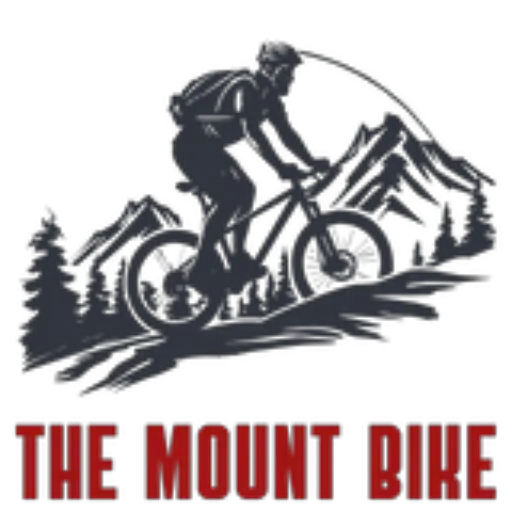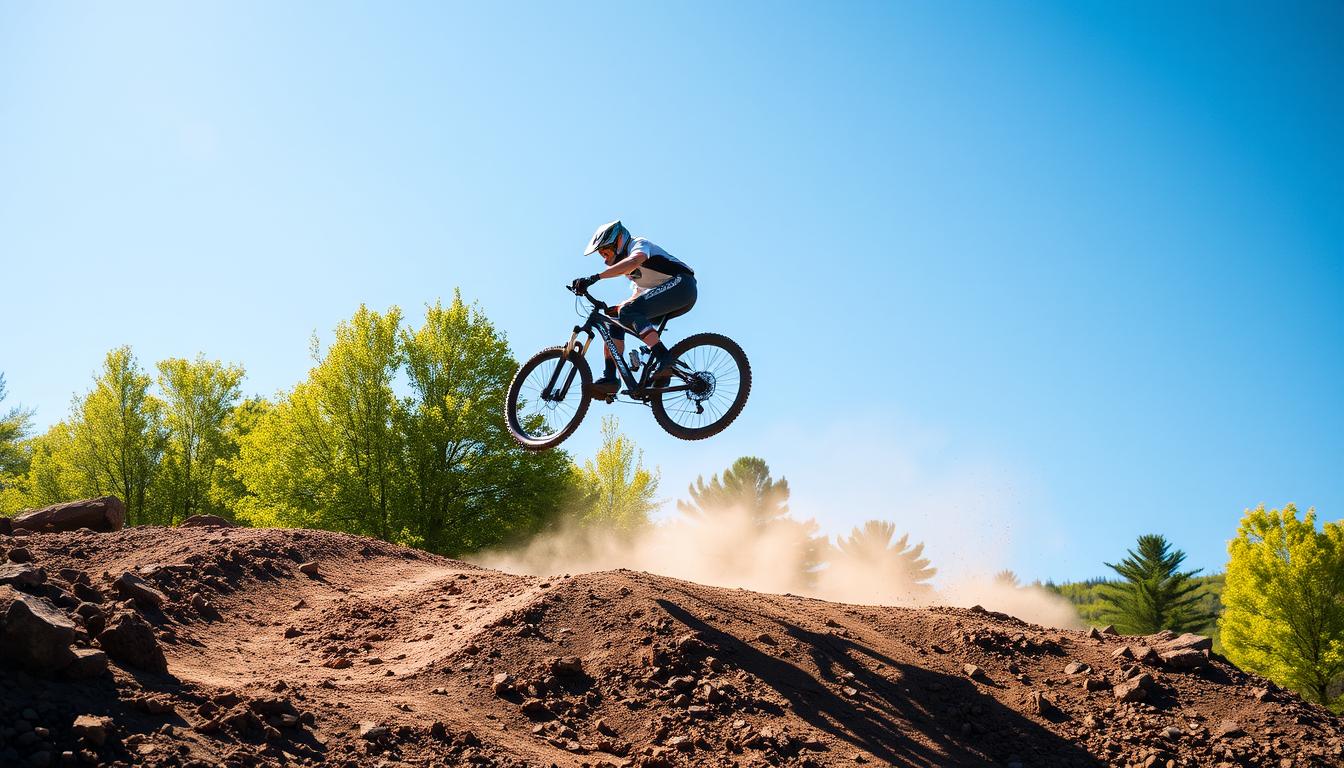Mastering jumps is key for mountain bikers. It needs physical fitness, mental toughness, and technical skills. To jump well, you must know the basics of mountain biking jump techniques and airtime.
In this article, we’ll guide you through conquering MTB jumps. We’ll cover safety gear, understanding jump types, body positioning, and basic techniques.
This guide is for both beginners and experienced riders. It will boost your jumping skills and elevate your MTB riding. We’ll discuss jump types, body positioning, and basic techniques.
Key Takeaways
- Mastering jumps requires a combination of physical fitness, mental toughness, and technical skills.
- Understanding mountain biking jump techniques is essential for improving jumping skills.
- Proper body positioning and basic technique breakdown are crucial for airtime on mountain bike.
- Learning how to jump mtb requires practice and dedication.
- Improving jumping skills can take your MTB riding to the next level.
- Understanding the difference between full-suspension and hardtail bikes is important for effective technique execution.
- Watching videos and getting feedback from coaches can help improve technique and build confidence.
Essential Safety Gear for MTB Jumping
When you’re mastering jumps on a mountain bike, safety comes first. The right safety gear can prevent injuries and make riding more fun. Start with the basics: a helmet, knee pads, elbow pads, and gloves.
A jumping skills tutorial stresses the need for protective gear. A helmet is key to protect your head in case of a fall. Knee and elbow pads help your joints, and gloves prevent hand injuries.
- Neck braces for high-speed and high-stakes riding
- Eye protection, including sunglasses or goggles
- Breakaway helmets that offer versatility and protection
Wearing the right gear and following tips for jumping on a mtb can reduce injury risk. Always prioritize safety, even more so when doing jumps and risky moves.
Understanding Jump Types on Mountain Bike Trails
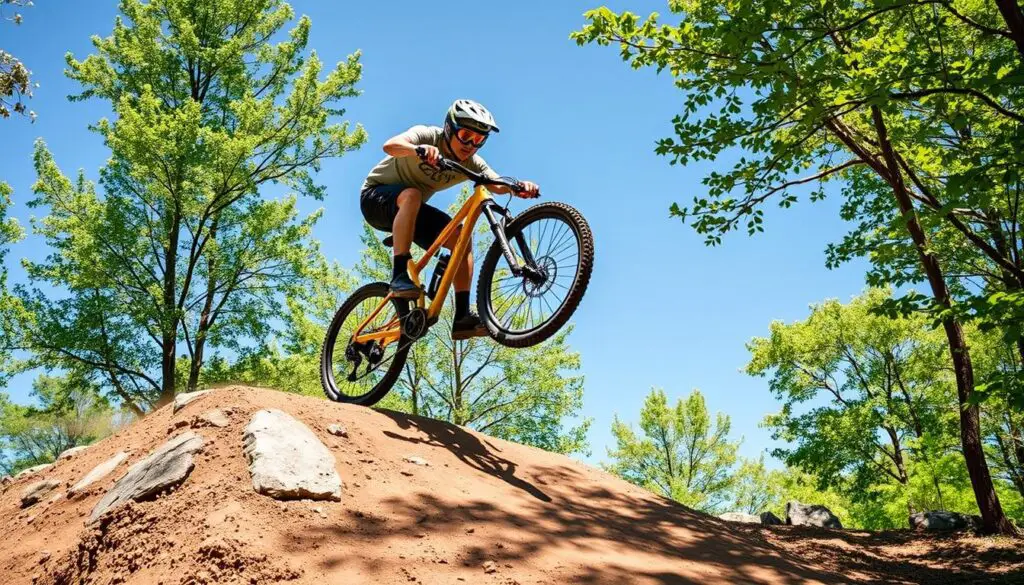
Getting good at airtime on mountain bike means knowing the different jumps. You’ll find table tops, gap jumps, and drop-offs. Each one is special and needs its own skill to ride well.
Start with table tops, as they’re the easiest. They help you get better and feel more confident. Always think you’ll succeed and only try jumps you can handle to stay safe.
Here are some tips to get better at jumping:
- Use speed and compression to clear gaps or table tops.
- Avoid mistakes like not compressing enough on take-off.
- Learn to land smoothly and use your body to absorb shock.
Try out different jumps like gaps and doubles. Knowing the best angle for jumps, about 45 degrees, can also help. With practice, you’ll get better at mtb jump technique and enjoy the ride more.
| Jump Type | Description | Difficulty Level |
|---|---|---|
| Table Top | A jump with a flat top and a gentle slope | Beginner |
| Gap Jump | A jump with a gap between the take-off and landing | Intermediate |
| Drop-off | A jump with a steep drop-off | Advanced |
Proper Body Positioning for MTB Jumps
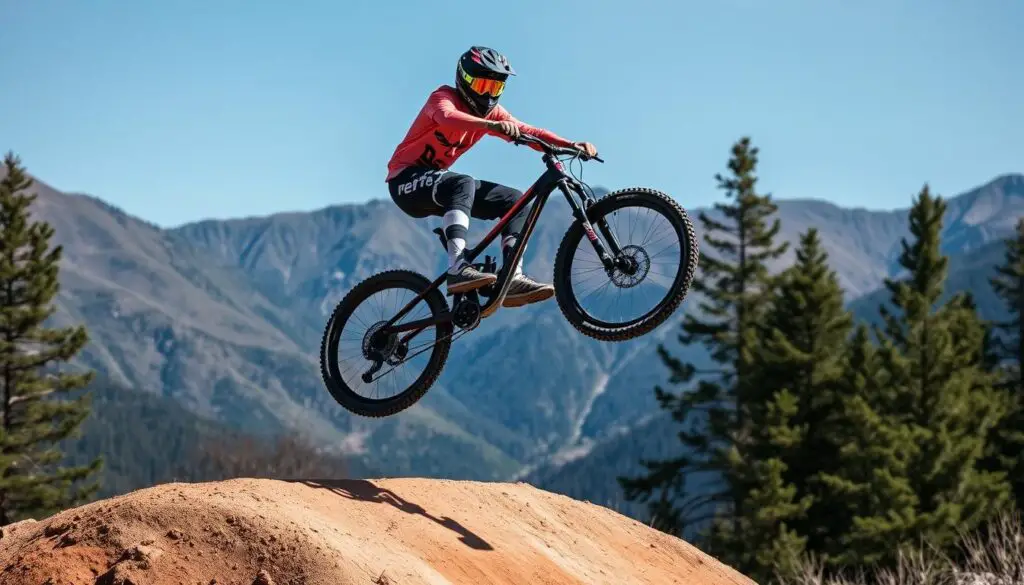
Learning how to jump MTB starts with the right body position. Simon Lawton, a top mountain biking instructor, says to always keep an attack position. This means your weight should be balanced over the bike, with bent knees and relaxed elbows.
To get this right, practice your balance and weight distribution. Stand over the bike with your feet apart and your dominant foot forward. As you get close to the jump, move your weight back and press down on the rear suspension to soften the landing.
- Keep your weight centered over the bike
- Keep your knees bent and your elbows relaxed
- Shift your weight slightly back as you approach the jump
- Compress the rear suspension to absorb the impact
By following these tips and practicing, you can get better at how to jump mtb. This will help you ride safer and more confidently on the trails.
| Jump Type | Body Positioning | Key Tips |
|---|---|---|
| Small Jump | Centered over the bike | Keep your weight back, compress the rear suspension |
| Large Jump | Slightly back from the bike | Shift your weight back, compress the rear suspension, and absorb the impact |
How to Jump MTB: Basic Technique Breakdown
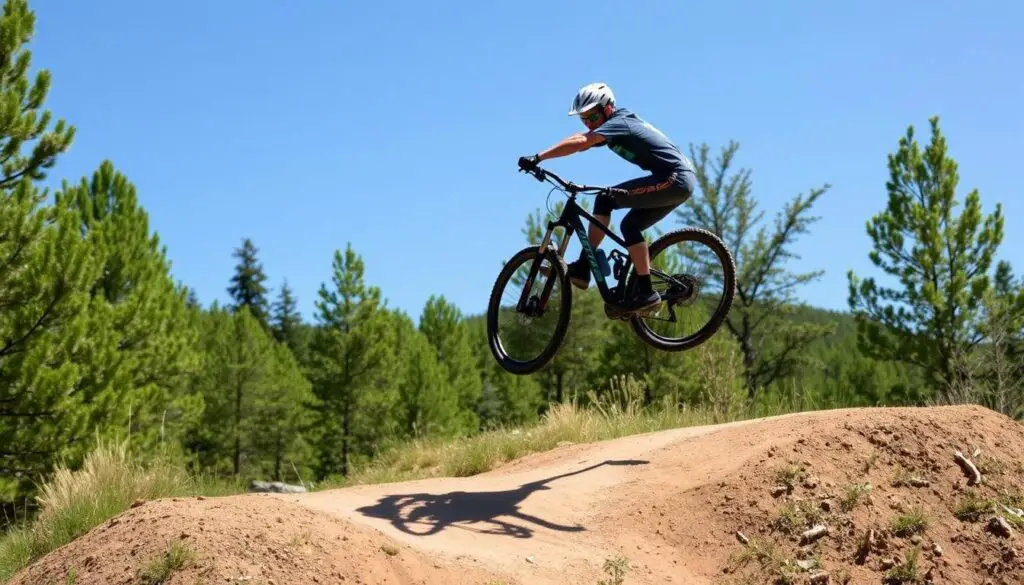
To jump on a mountain bike, you need to know the basic technique. Approaching the jump at a moderate speed is key. It lets you compress the suspension and lift the front wheel. This is a basic step in tips for jumping on a mtb, helping you stay in control and balanced in the air.
A jumping skills tutorial will tell you to keep your legs driving consistently. This improves your control and stability in the air. It also helps you avoid sudden movements. Plus, tricks for jumping on a mtb include trying out various jumps. This helps you get better and feel more confident.
Here are some important tips for learning to jump on a mountain bike:
- Approach the jump at a moderate speed
- Compress the suspension and lift the front wheel
- Maintain a consistent drive with the legs throughout the shape of the jump
- Practice different types of jumps to develop your skills and build confidence
By following these tips and practicing often, you can get better at jumping on a mountain bike. Always wear the right safety gear and ride within your limits.
| Jump Type | Description |
|---|---|
| Pump Track | A type of jump that involves pumping the bike to gain speed and airtime |
| Dirt Jump | A type of jump that involves riding over a mound of dirt to gain airtime |
Mastering the Takeoff Phase
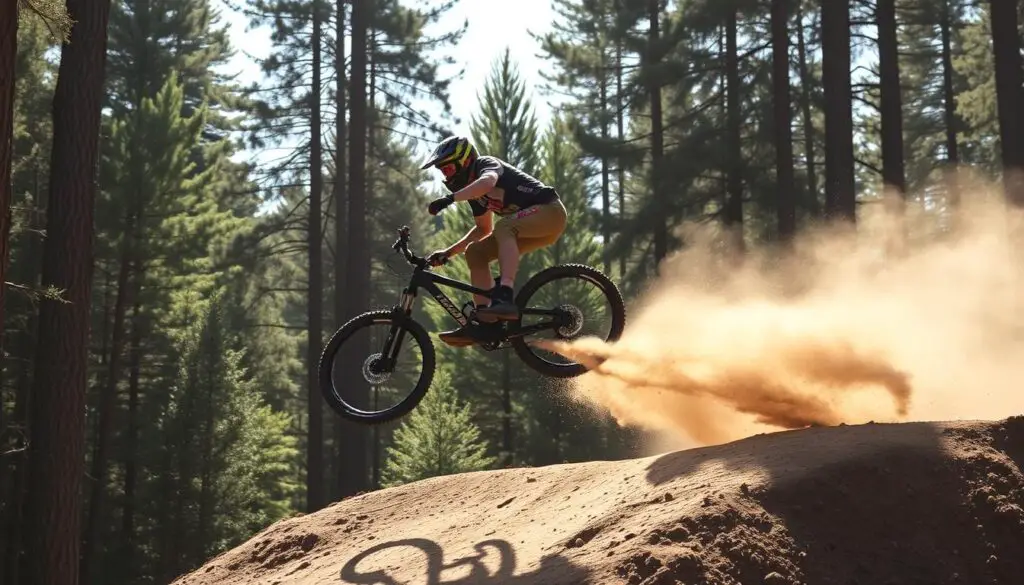
To get better at improving your mtb jump technique, mastering the takeoff phase is key. It’s about controlling your speed, navigating the lip, and timing your jump for the best airtime on mountain bike. These skills help riders jump with confidence and precision.
When you’re about to jump, think about a few important things:
- Adjust your speed to fit the jump size and type
- Learn to position your bike for a smooth takeoff
- Time your jump right with the bike’s movement
Mastering these skills improves your mtb jump technique and makes riding more fun. As you get better, you can tackle harder jumps. This boosts your airtime on mountain bike and performance.
Practice and patience are crucial for a strong takeoff phase. With hard work and persistence, riders can improve their skills. They’ll enjoy more airtime on mountain bike and a more exciting ride.
Airtime Control and Management
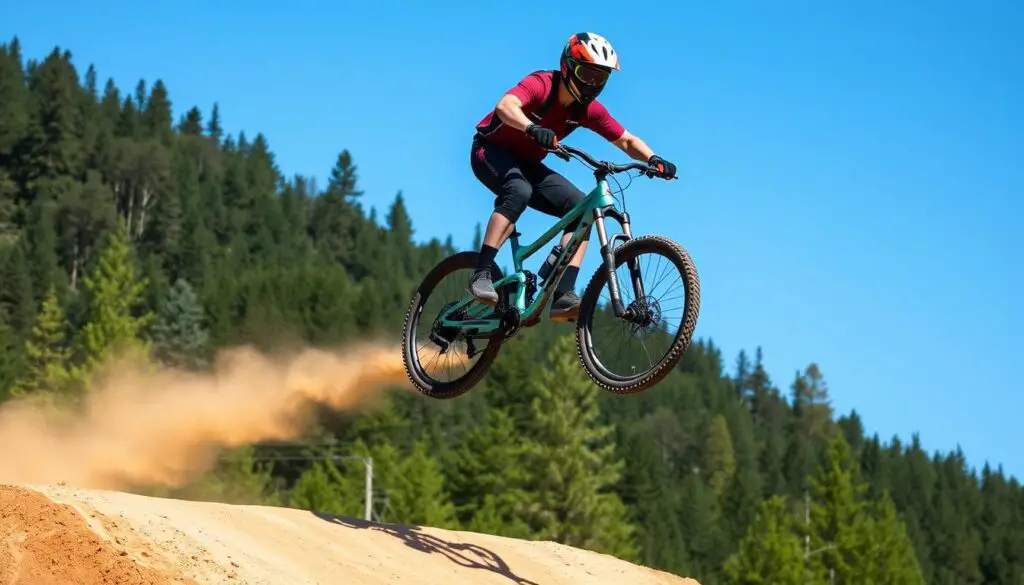
Learning mountain biking jump techniques means understanding airtime control and management. This is key to riding safely and smoothly. It helps you control the bike while airborne and land well.
Improving your mtb jump technique boosts your performance and safety. It’s all about mastering tricks for jumping on a mtb. This includes adjusting your body and bike handling.
Here are some tips for better airtime control and management:
- Keep your weight centered over the bike
- Adjust your body position to maintain balance and control
- Use your arms and legs to absorb shock and stabilize the bike
Follow these tips and practice often. This will help you master mountain biking jump techniques. Always stay focused and ride within your limits. Keep working on improving your mtb jump technique for a safe and fun ride.
| Technique | Description |
|---|---|
| Airtime Control | Maintaining control of the bike during flight |
| Landing Management | Managing the landing for a smooth and safe ride |
Perfecting Your Landing Technique
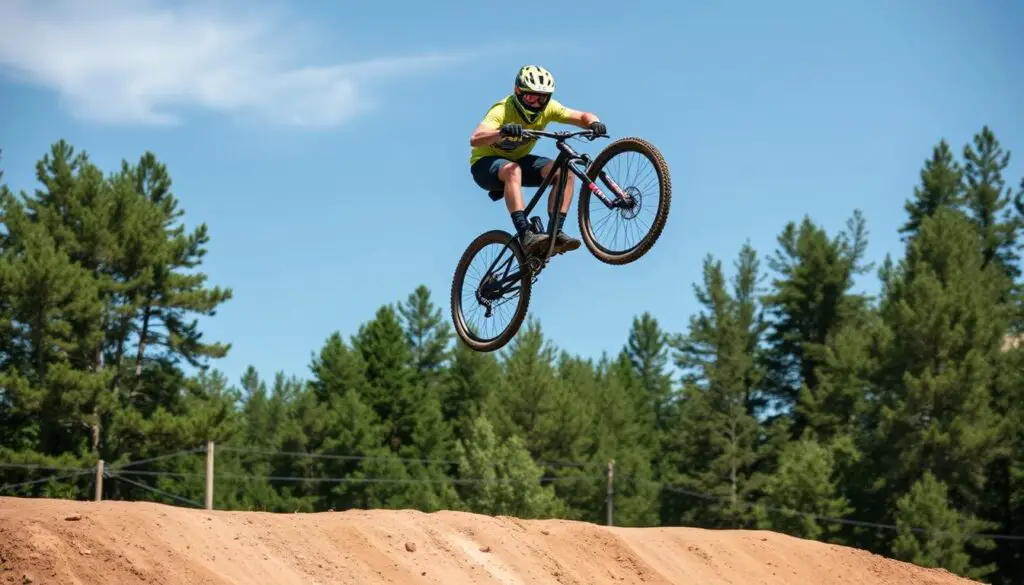
Learning how to jump mtb means mastering your landing. It’s key for a safe ride. You need to check the landing area, absorb shock, and bounce back smoothly. With tips for jumping on a mtb, you can land better and avoid injuries or bike damage.
A jumping skills tutorial must talk about landing. First, look for a flat landing spot. As you land, bend your body and use your legs to soften the impact. Then, adjust your speed and position to keep control.
- Spot the landing early to understand the angle of approach
- Lead with the front wheel to initiate the landing correctly
- Use body English and leg movements to bring the rear wheel around
- Keep your eye on the landing throughout the jump
| Landing Technique | Description |
|---|---|
| Front Wheel First | Landing on the front wheel first, with the rear wheel following |
| Rear Wheel First | Landing on the rear wheel first, with the front wheel following |
| Nose-Down Landing | Landing with the nose of the bike pointed downwards, to reduce the impact |
By practicing these tips, you’ll get better at how to jump mtb. You’ll ride more confidently and smoothly. Always use tips for jumping on a mtb and take a jumping skills tutorial to master your landing.
Building Progressive Jump Lines
Improving your mtb jump technique means building progressive jump lines. Start with table tops, then move to gap jumps and drop-offs. This will help you increase your airtime and improve your skills.
Choosing the right table tops is key. Look for ones with a gradual incline and smooth landing. This builds confidence and prepares you for harder jumps. Gap jumps need more speed and precision. Always check the gap’s difficulty and adjust your approach.
Table Top Selection
Start with table tops around 3’6″ to 4’5″ high. As you get better, try jumps with a 9-10 foot gap.
Gap Jump Progression
Gap jumps need more speed and pop. Start with small gaps and increase them as you get more confident. Focus on your airtime to stay in control and land smoothly.
Drop Practice Methods
Drop-offs help you practice landing and build confidence. Start with small drops and increase the height as you get more comfortable. Keep your weight centered and body positioned right to absorb the landing. Mastering drop-offs will help you tackle harder jumps.
| Jump Type | Height | Lip to Landing Gap |
|---|---|---|
| Table Top | 3’6″ – 4’5″ | 7-8 feet |
| Gap Jump | 4’5″ – 6′ | 9-10 feet |
| Drop-off | 2′ – 4′ | N/A |
Follow these tips and practice often to improve your mtb jump technique. Stay focused on your airtime and adjust your technique to land smoothly.
Common Jumping Mistakes and Solutions
Jumping on a mountain bike can be tricky. Many mistakes can lead to accidents or failed jumps. To get better, it’s key to know and fix these errors. One big mistake is bad body positioning, which can make it hard to control and balance.
A good tip is to focus on how you distribute your weight and keep a neutral bike position. Stand at a 45-degree angle with your hips and keep your knees a bit bent. Also, smooth throttle use is important for a good jump. Being too rough can cause you to lose control.
Another mistake is guessing the gap wrong, which can mess up your landing. To fix this, start with small jumps and work your way up. This builds your confidence and skill, helping you judge the gap better and land right.
- Practice absorbing impacts from hard landings
- Allow the bike to come into your legs for a smoother landing
- Follow an experienced rider’s speed and keep the pedals level during jumps
By avoiding these common mistakes and following these tips, you can boost your jumping skills. This will make you a more confident and skilled mountain biker.
Advanced Jumping Techniques and Variations
As riders get better at mountain biking, they look to improve their skills. They want to learn how to jump with style and precision. Understanding mountain biking jump techniques and how to get more airtime on mountain bike jumps is key.
Advanced jumping includes whips, scrubs, and other style moves. These need bike control, body positioning, and timing. By practicing, riders can create a unique style that stands out.
Technical Jump Combinations
To improve your jumping, try technical jump combinations. This means linking jumps, using different types, and trying various takeoff and landing methods. Mastering these can make your jumps complex and show off your skills.
- Focus on developing a consistent and controlled takeoff technique
- Experiment with different body positions and movements to achieve the desired style and airtime
- Practice linking multiple jumps together to create complex and challenging jump lines
| Technique | Description |
|---|---|
| Whips | A type of jump that involves twisting the bike in mid-air |
| Scrubs | A type of jump that involves lowering the bike’s suspension to absorb the impact of landing |
| Style Modifications | Techniques used to add style and flair to jumps, such as tail whips and bar spins |
By adding these advanced techniques to your routine, you can elevate your mountain biking skills. You’ll develop a unique and stylish riding style.
Mental Preparation and Confidence Building
Getting better at mtb jumping needs both physical skill and mental prep. To jump well on a mtb, you must have a positive mindset, build confidence, and handle fear. A good jumping skills tutorial can help you overcome mental hurdles and boost your performance.
Experts say mental prep is crucial for MTB jumping success. This means visualizing yourself doing well, like navigating jumps and drops. By focusing on good outcomes and repeating successful moments, you build confidence and a growth mindset.
Some important ways to prepare mentally and build confidence include:
- Practicing systematic desensitization to beat fear and anxiety
- Setting realistic goals and tracking your progress
- Getting professional guidance from a skills coach or experienced rider
- Creating a pre-ride routine to get focused and ready
By using these strategies in your training, you can boost your mental prep and confidence. This will lead to better performance and a more fun ride. Whether you want to get better at mtb jumping or just feel more confident on the trails, combining physical skill with mental prep is essential.
Conclusion: Taking Your MTB Jumping to the Next Level
Learning to jump on a mountain bike takes time, effort, and practice. With the right techniques, you can boost your skills and reach new heights. Focus on airtime on mountain bike to get the most out of your jumps.
Experienced riders say timing is key for good jumps. Try to “pop” when the front tire leaves the jump’s edge. Also, keep your upper body relaxed and your body in the right position for a smooth landing.
With regular practice, you can become a skilled mountain biker. Always check your landing spots, keep your speed up, and balance your body. By mastering these basics, you’ll improve your mountain biking skills.

I am Ryan Ford, a mountain biking enthusiast who loves to explore the outdoors. I also like to go on adventures with friends and anything else that involves being outside. I love my bike because it gets me out of the house and gives me an opportunity to enjoy nature.
